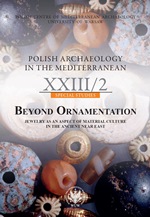Cowrie shells and their imitations as ornamental amulets in Egypt and the Near East
Cowrie shells and their imitations as ornamental amulets in Egypt and the Near East
Author(s): Amir GolaniSubject(s): Archaeology
Published by: Wydawnictwa Uniwersytetu Warszawskiego
Keywords: cowrie shells, shell ornaments, amulets, ancient jewelry, imitation, Near East, ancient Egypt
Summary/Abstract: Shells of the genus Cypraea, commonly known as “cowries”, are common finds in archaeological excavations throughout the Near East from the prehistoric period onward. They are often found modified by the removal of their backs in order to facilitate stringing. Although certain species of these shells were historically used as currency, their prime importance was as amuletic jewellery. The extensive distribution and chronological time span of these shells attests to their immense popularity among many ancient and unrelated cultures. Their value stems probably from the suggestive form of the shell itself, the shell being considered as a protective amulet guarding against sterility, ensuring fertility and warding off the “evil eye”. While the shell itself may have been acquired by trade, the form of the shell was emulated in other materials that afforded the form added symbolic power.
Journal: Polish Archaeology in the Mediterranean
- Issue Year: 2/2014
- Issue No: XXIII
- Page Range: 71-83
- Page Count: 13
- Language: English

